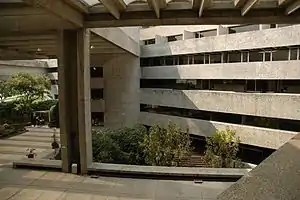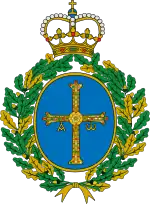El Colegio de México
El Colegio de México, A.C. (commonly known as Colmex, English: The College of Mexico) is a prestigious Mexican institute of higher education, specializing in teaching and research in social sciences and humanities. This Institution received the Prince of Asturias Award for Social Sciences in 2001. The library of El Colegio de México (Biblioteca Daniel Cosío Villegas) is one of the largest academic libraries in Mexico, and it contains one of the most important Latin American collections in social sciences and humanities.[3]
 El Colegio de México | |
| Type | Public |
|---|---|
| Established | October 8, 1940 |
| Endowment | US$47.46 million (2011)[1] |
| President | Silvia Giorguli Saucedo |
Academic staff | 178[2] |
| Students | 458 |
| Undergraduates | 153 |
| Postgraduates | 305 |
| Location | , D.F. , |
| Campus | Urban |
| Colors | COLMEX Crimson |
| Website | Colmex.mx |
The college was founded in 1940 by the Mexican Federal Government, the Bank of Mexico (Banco de México), the National Autonomous University of Mexico (UNAM), and the Fondo de Cultura Económica. After the Spanish Civil War, the President of Mexico Lázaro Cardenas created The House of Spain in Mexico (1938–1940) to host the Spanish intellectuals in exile in that country. Under the direction of renowned intellectual Alfonso Reyes, the House of Spain became a higher education center, and was renamed El Colegio de México in 1940. The College now operates under a 1961 charter that allows the institution to provide college-level teaching in the fields of humanistic knowledge and social and political sciences. In 1976, the university's campus was moved from the Colonia Roma (a historic neighborhood of Mexico City) to its current location.[4]
The college encompasses seven separate academic centers, teaching a total of three degrees, seven master's degrees and eight doctorates. The campus is located in a purpose-built and architecturally striking building on the southern fringes of Mexico City, and it was designed by Mexican architect Teodoro González de León.
History

It arose from an organization of Spanish civil war exiles called "Casa de España en México" (House of Spain in Mexico). In March 1939, Lázaro Cárdenas named Alfonso Reyes to the presidency of the "Casa de España en México". Reyes would be president of the "Colegio" until his death. Historian Daniel Cosío Villegas played an important role in its institutionalization and the Colegio's library bears his name.
Academics
Students
| Undergraduate | Graduate | Ph.D. | |
|---|---|---|---|
| Men | 57% | 49% | 44% |
| Women | 43% | 51% | 56% |
| International Students | 4% | 12% | 30% |
Colmex's student population includes 74 undergraduate and 369 graduate students representing diverse geographic and linguistic backgrounds. Of the entire student population, 83.5% are from Mexico, while 16.05% are from outside the country (including the United States, France, Italy and China). International students hail from about 24 different countries, with Colombians comprising about one third of all international students in the entering class of 2011.[6]
Undergraduate and graduate admission to Colmex is very selective.[6] El Colegio de México received 936 applications for admission to the Class of 2014 and 181 were admitted (18.1%). 87% of students graduate within 4 years.[6]
Research Centers

In the 2010–2011 school year, El Colegio de México offered 19 academic programs in seven academic centers, of which 16 are doctoral and master's graduate degree programs.[7] Despite strong increases in university enrollment across Mexico,[8] El Colegio de México has upheld a low and appealing student-faculty ratio of 2.5:1. There are nearly 181 tenured or tenure-track professors and 50 adjunct and visiting professors teaching at the college.[6]
21% of all students are enrolled in the Centre for International Studies, Colmex's largest academic unit. Of the other larger centers, the Centre for Demographic, Urban and Environmental Studies enrolls 19%, the Centre for Historical Studies enrolls 15%, the Centre for Linguistic and Literary Studies enrolls 13%, the Centre for Economic Studies and the Centre for Sociological Studies enroll about 10% each.[9] The remainder of all students are enrolled in Colmex's smaller schools, including the Centre of Asian and African Studies and the Daniel Cosío Villegas Library, which is also one of the richest libraries in North America, with sources in many languages.
Since 1991, El Colegio de México is the host institution of LEAD-Mexico (Leadership for Environment and Development), a program established by The Rockefeller Foundation to bring together and train mid-career leaders from all parts of the world in improving their leadership skills around the issues of sustainable development . Led primarily by renowned Colmex professor Boris Graizbord, Lead Mexico responds to calls for acting as consultant, advisor, and policy evaluator at federal and local level.[10]
Daniel Cosío Villegas Library
The Daniel Cosío Villegas Library is a public academic library situated in the center of El Colegio de México's campus, contains around 700,000 volumes, and comprises 30% of the total building real estate.[11] The library is composed of eighteen academic librarians, three IT professionals, and eighty clerical staff and paraprofessionals.[11] The library's curatorial efforts have transformed the collection into one of the most important Latin America collections in its areas of specialty and its staff has played an important role both for the campus and the national academic library practices by driving various initiatives such as the migration to online OPAC systems in the 90's, which spurred other institutions in Mexico to follow.[11]
Notable people
| Alfonso Reyes | 1940–1958 |
| Daniel Cosío Villegas | 1958–1963 |
| Silvio Zavala | 1963–1966 |
| Víctor Luis Urquidi Bingham | 1966–1985 |
| Mario Ojeda Gómez | 1985–1994 |
| Andrés Lira | 1994–2005 |
| Francisco Javier Garciadiego Dantán | 2005–2015 |
| Silvia Giorguli Saucedo | 2015–present |
Faculty and staff
- See El Colegio de México faculty
Prominent scholars and intellectuals have been among the faculty of the various centers, such as Alfonso Reyes, Daniel Cosío Villegas, Mario Ojeda Gómez, Víctor Urquidi, Luis Unikel and Rafael Segovia Canosa. For 2010, from a total of 181 faculty and staff members, 92% were affiliated with the National System of Researchers (abbreviated as SNI, in Spanish) of the Consejo Nacional de Ciencia y Tecnología (the National Council of Science and Technology of Mexico).[5]
Among the best-known faculty of El Colegio de México are Lorenzo Meyer, Mauricio Merino, Antonio Alatorre; political leaders Jesús Silva Herzog Flores, Carlos Tello Macías, Natividad González Parás, Porfirio Muñoz Ledo, Bernardo Sepúlveda; scholars Sergio Aguayo, Soledad Loaeza, Rodolfo Stavenhagen, Luis F. Aguilar Villanueva, Pilar Gonzalbo Aizpuru, Francisco Gil Villegas, Margit Frenk, Francisco Segovia, Saurabh Dube, Gustavo Garza, and the 2007 UN-HABITAT Lecture Award urbanist Martha Schteingart.
Alumni
- See El Colegio de México alumni

Among the people who have attended El Colegio de México are Mexican political leaders Marcelo Ebrard, former Head of Government of Mexico City; economist Jaime Serra Puche, cabinet member under the Carlos Salinas and Ernesto Zedillo administrations and Sócrates Rizzo, former Governor of Nuevo León; diplomats Patricia Espinosa, former Secretary of Foreign Affairs, Arturo Sarukhán, former Mexican ambassador to the United States, Claude Heller, ambassador of Mexico to the UN, Adolfo Aguilar Zínser, former ambassador of Mexico to the UN Security Council and senator Rosario Green, Secretary of Foreign Affairs during the Zedillo administration; historian Enrique Krauze; writers such as Pablo Soler Frost and Héctor Aguilar Camín; Secretary of State of the Mexican State of Nuevo León and former Senior Vice President of CEMEX Javier Trevino; political analyst and writer Denise Dresser; current president of Salisbury University in Salisbury, Maryland Janet Dudley-Eshbach; historian Andrés Reséndez; and narratologist Lauro Zavala.
References
- "SHCP El Colegio de México, Portal de transparencia" (PDF). IFAI. Retrieved July 30, 2012.
- "El Colegio de México, Informe de actividades 2016" (PDF). COLMEX. Archived from the original (PDF) on April 5, 2018. Retrieved April 4, 2018.
- "Biblioteca Daniel Cosío Villegas". El Colegio de México. Retrieved December 21, 2011.
- "Historia de El Colegio de México". El Colegio de México. Archived from the original on April 13, 2016. Retrieved December 21, 2011.
- "Informe Anual de actividades: 2010". El Colegio de México. Archived from the original on April 15, 2012. Retrieved December 21, 2011.
- "Informes de actividades". El Colegio de México. Archived from the original on 2012-10-12. Retrieved 2012-09-23.
- "Programas académicos". El Colegio de México. Archived from the original on 2012-09-19. Retrieved 2012-09-23.
- "Crece matrícula de universidades: SEP". El Universal. Retrieved 2012-09-23.
- "Informe académico 2011" (PDF). El Colegio de México. Archived from the original (PDF) on 2013-09-19. Retrieved 2012-09-23.
- "Lead-Mexico" (PDF). Lead Mexico. Retrieved 2012-09-23.
- Martínez, Alberto Santiago. «Constructing a Model for Mexican Libraries in the 21st Century». En Dynamic Research Support in Academic Libraries. Facet Publishing, 2016.
Publications
- Torre Villar, Ernesto De La (1981). Torre Villar, Ernesto De La (ed.). Asia and Colonial Latin America: XXX International Congress of Human Sciences in Asia and North Africa. Contributors Ernesto De La Torre Villar, Colegio de México (illustrated ed.). Colegio de México. ISBN 9681201140. Retrieved 24 April 2014.
